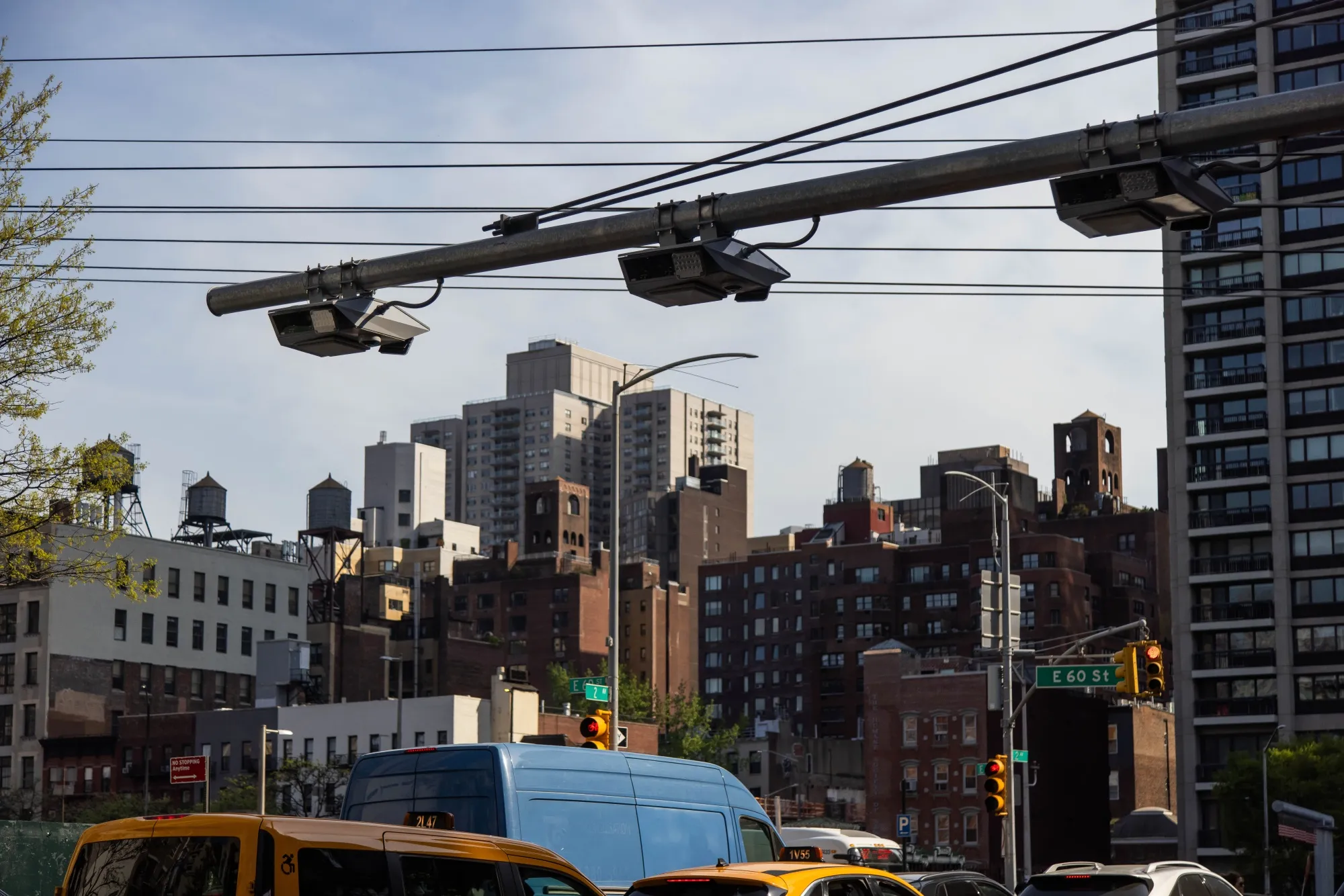- Program Launch: NYC began charging drivers on Jan. 5, 2025 to reduce congestion, improve air quality, and raise $15B for transit upgrades.
- Opposition: Critics spanning NJ Governor Phil Murphy to former President Trump warned the $9 fee would harm small businesses and hardworking families, but the plan survived years of debate.
- Pollution & Traffic: A Cornell study and MTA data show pollution down about 22% and an 11% drop in vehicles (71,500 fewer per day, 23.7M fewer annually) in the tolled zone.
- MTA Revenue: The authority is likely to exceed its $500M net revenue goal with $548.3M through December and plans to issue congestion-pricing bonds to finance $15B of infrastructure work.
- Funding Uncertainty: A legal challenge rooted in actions from the Trump administration threatens the MTA’s planned borrowing against congestion pricing revenue next year.
- Visitor Trends: Despite the toll, the area south of 60th Street drew 3.4% more visitors than in 2024 versus a 1.4% Manhattan-wide rise.
- Retail Vacancies: Midtown and downtown storefront vacancy dipped to 15.5% in Q3, 0.9 percentage point lower than the same period in 2024 and better than Manhattan overall.
- Sales Tax: January through November sales-tax collections reached $9.9B, marking a 6.3% year-over-year increase and outpacing neighboring counties.
CityLab
Traffic enters the Congestion Relief Zone from the Ed Koch Queensboro Bridge in New York.
Photographer: Michael Nagle/Bloomberg
In this Article
[
New York University
Private company
](/quote/321042Z:US)
[Contact us:
Provide news feedback or report an error
](https://www.bloomberg.com/help/question/submit-feedback-news-coverage/)
[Confidential tip?
Send a tip to our reporters
](https://www.bloomberg.com/tips/)
[Site feedback:
Take our SurveyNew Window
](https://bmedia.iad1.qualtrics.com/jfe/form/SV_0xQ0jMsQ7QLRlj0?slug=2025-12-22/nyc-congestion-pricing-is-the-controversial-program-working)
By Michelle Kaske and Aaron Gordon
December 22, 2025 at 12:00 PM GMT+1
BPC > enable JavaScript for site
Takeaways by Bloomberg AI
- Congestion pricing is working as planned, with a significant drop in pollution and traffic declining by 11% in the tolled zone.
- The Metropolitan Transportation Authority is poised to beat its target of generating $500 million of revenue from the program after expenses.
- Despite initial concerns, the business impact in the district doesn't appear to be as onerous as some had feared, with a 3.4% increase in visitors and a 6.3% boost in sales-tax revenue.
Nearly a year ago, New York City embarked on a controversial program to toll drivers entering some of Manhattan’s busiest streets. The goal of the congestion pricing plan, the first of its kind in the US, was to improve air quality and raise $15 billion to upgrade the city’s extensive — and aging — transit system, all while relieving traffic in a routinely clogged part of town.
Critics of the initiative warned that imposing a $9 fee on most drivers would dampen economic activity in an area that was still trying to rebound from the Covid-19 pandemic, while placing an outsized burden on small businesses and working families. Opponents ranged from New Jersey Governor Phil Murphy, a Democrat, to Republican President Donald Trump, and it narrowly survived years of political bickering before finally become a reality on Jan. 5.
E-ZPass readers and license plate-scanning cameras over Second Avenue in Manhattan.Photographer: Michael Nagle/Bloomberg
Despite all that, congestion pricing by a number of measures is working as planned, a reality that may turn New York’s experiment into a blueprint for other US urban centers. Early indicators point to a significant drop in pollution in parts of Manhattan, according to a Cornell University study, with traffic declining by 11% in the tolled zone. The Metropolitan Transportation Authority, which implemented the new toll, is poised to beat its target this year of generating $500 million of revenue from the program after expenses. And the business impact in the district, which runs from 60th street to the southern tip of Manhattan, doesn’t appear to be as onerous as some had feared.
“I undoubtably see it as a success, in the reduction of traffic, the improvement of public safety and air quality and the funding of public transportation needs,” said Sarah Kaufman, director of New York University’s Rudin Center for Transportation.
Challenges remain. The MTA’s plans to borrow against congestion pricing revenue as soon as next year are in limbo as the program faces a major legal hurdleBloomberg Terminal stemming from the Trump administration. And yet based on results, congestion pricing is doing its job. These five charts show how:
Congestion is down. The toll immediately created a financial disincentive to drive south of 60th Street, and an average of 71,500 fewer vehicles entered the area each day from January through November. That’s an 11% reduction from 2024, according to the MTA. A total of nearly 23.7 million fewer vehicles have entered the area in the first eleven months of this year, the MTA said. That helped the authority’s buses pick up the pace — a little bit— in and around the central business district, making mass transit a more appealing option when every minute counts.
Revenue is up. The MTA’s goal was to collect $500 million of net revenue in 2025 from the new toll — or roughly $42 million a month, on average — and the agency is poised to surpass that target with an anticipated $548.3 million generated through December, according to MTA documents. The transit agency is planning to sell its first-ever congestion-pricing bonds in 2026, secured by the new toll revenue. Over time the MTA will issue $15 billion of such debt to help modernize train signals, add elevators to subway stations and extend the Second Avenue subway to Harlem.
It’s busier. A major concern with implementing a congestion pricing toll was that fewer people would come into the area for shopping, appointments, entertainment and dining. But not only did people still seek out neighborhoods south of 60th, that area saw a 3.4% increase in visitors from 2024, a bigger boost than the 1.4% gain across all of Manhattan.
Filling up: The higher storefront rents in Midtown and downtown neighborhoods tend to keep vacancy rates for those areas above the rest of the city. Still, the 15.5% vacancy rate in the third quarter of this year is 0.9 percentage point less than the same period in 2024, a bigger decline than all of Manhattan and better than the city’s flat performance as a whole.
Business is good. Even with the toll, residents, visitors and commuters were steady spenders in the city, which pulled in $9.9 billion of sales-tax revenue from January through November, a 6.3% boost compared with the same period in 2024. New York City as a whole performed better than its neighboring counties, which saw smaller increases in sales-tax collections.
Get Alerts for:
[Contact us:
Provide news feedback or report an error
](https://www.bloomberg.com/help/question/submit-feedback-news-coverage/)
[Site feedback:
Take our SurveyNew Window
](https://bmedia.iad1.qualtrics.com/jfe/form/SV_0xQ0jMsQ7QLRlj0?slug=2025-12-22/nyc-congestion-pricing-is-the-controversial-program-working)
[Confidential tip?
Send a tip to our reporters
](https://www.bloomberg.com/tips/)
[
Before it's here, it's on the Bloomberg Terminal
Bloomberg Terminal LEARN MORE
](https://www.bloomberg.com/professional/solution/bloomberg-terminal-learn-more/?utm_source=bbg&utm_medium=intpro&utm_campaign=trmnl&utm_content=web_dotcom&tactic=794999)
Markets at a Glance
Dow Jones Industrial Average
48,731.16
Arrow Up
0.60%
S&P 500 INDEX
6,932.05
Arrow Up
0.32%
NASDAQ Composite Index
23,613.31
Arrow Up
0.22%
Bloomberg 500 Index
2,508.26
Arrow Up
0.32%
S&P/TSX Composite Index
31,999.76
Arrow Down
0.18%
S&P/BMV IPC
65,616.43
Arrow Up
0.03%
Create Your List to follow what interests you
Bloomberg European 500 Index **To be discontinued on April 1, 2024**
Arrow Up
0.00%
No data available
EURO STOXX 50 Price EUR
5,746.24
Arrow Down
0.05%
FTSE 100 Index
9,870.68
Arrow Down
0.19%
CAC 40
8,103.58
Arrow Down
0.00%
Deutsche Boerse AG German Stock Index DAX
24,340.06
Arrow Up
0.23%
IBEX 35 Index
17,172.90
Arrow Down
0.06%
Create Your List to follow what interests you
Nikkei 225
50,407.79
Arrow Up
0.13%
Hang Seng Index
25,818.93
Arrow Up
0.17%
Shanghai Shenzhen CSI 300 Index
4,642.54
Arrow Up
0.18%
S&P/ASX 200
8,762.70
Arrow Down
0.38%
BSE SENSEX
85,408.70
Arrow Down
0.14%
Korea Stock Exchange KOSPI Index
4,108.62
Arrow Down
0.21%
Create Your List to follow what interests you
Sign in or Create an Account to customize your list.
[
Before it's here, it's on the Bloomberg Terminal
Bloomberg Terminal LEARN MORE
](https://www.bloomberg.com/professional/solution/bloomberg-terminal-learn-more/?utm_source=bbg&utm_medium=intpro&utm_campaign=trmnl&utm_content=web_dotcom&tactic=794999)
More From Bloomberg
[

NYC Congestion-Pricing Judge Delays Ruling, Sets Jan. 28 Hearing
](https://www.bloomberg.com/news/articles/2025-12-23/nyc-congestion-pricing-judge-delays-ruling-sets-jan-28-hearing)[

George Conway to Run as a Democrat for Nadler’s Manhattan Seat
](https://www.bloomberg.com/news/articles/2025-12-22/george-conway-to-run-as-a-democrat-for-nadler-s-manhattan-seat)[

400 Capital Sues Over Alleged Fee-Grabbing Tactic in CMBS Loan
](https://www.bloomberg.com/news/articles/2025-12-24/400-capital-sues-over-alleged-fee-grabbing-tactic-in-cmbs-loan)[

Casinos Are a Bad Bet for US Cities
](https://www.bloomberg.com/opinion/articles/2025-12-24/casinos-are-a-bad-bet-for-american-cities)[

How Birthright Citizenship Sort of Saved Christmas
](https://www.bloomberg.com/opinion/articles/2025-12-24/how-birthright-citizenship-sort-of-saved-christmas)
Top Reads
[

China’s EV Battery Giant Is Trying to Find a New Road
by Bloomberg Businessweek
](https://www.bloomberg.com/news/features/2025-12-23/ev-battery-giant-catl-s-expansion-plans-face-trump-and-european-pushback)[

Elon Musk Demanded Tesla’s Electric Doors Despite Safety Worries
by David Welch, Edward Ludlow and Dana Hull
](https://www.bloomberg.com/news/features/2025-12-22/elon-musk-was-warned-of-potential-tesla-door-safety-issues)[

15 People Have Died in Crashes Where Tesla Doors Wouldn’t Open
by Dana Hull
](https://www.bloomberg.com/news/features/2025-12-22/tesla-door-safety-tied-to-at-least-15-auto-accident-deaths)[

How Trump Is Rerouting Trillions in Capital
by Katanga Johnson, Patrick Clark, Olga Kharif, Ari Natter, Alison mcneely and Allison McNeely
](https://www.bloomberg.com/graphics/2025-capital-flow-trump/)















